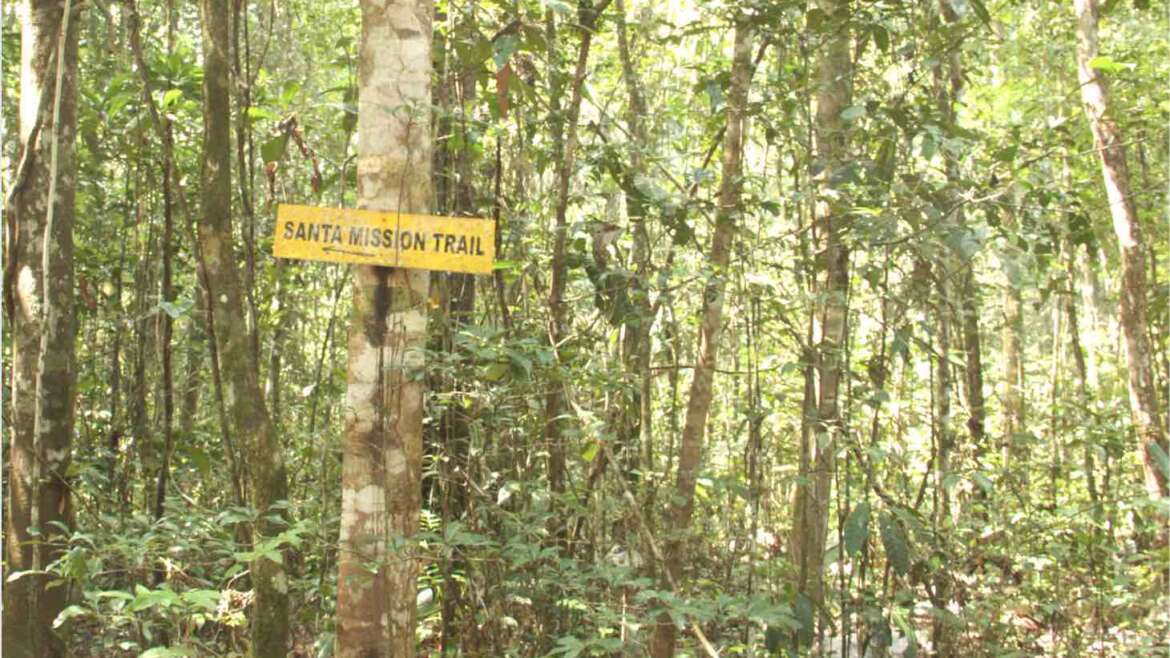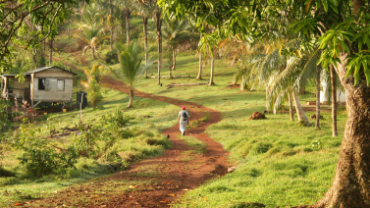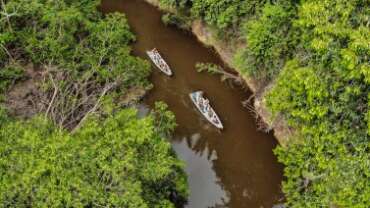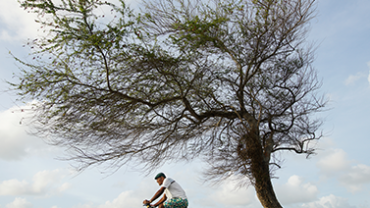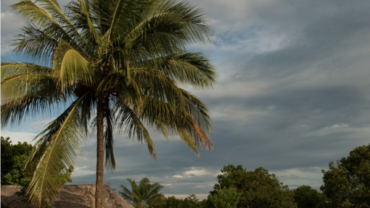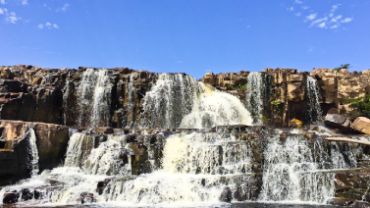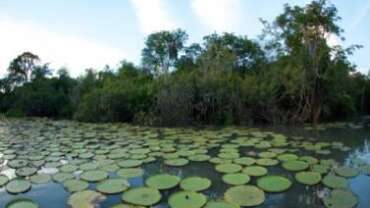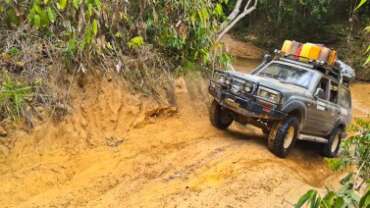Adventure Tourism in Guyana
Undiscovered by many, adventures in Guyana are accessible to everyone from travellers seeking soft adventure to those who prefer an adrenaline rush. From hikes, treks, and mountain biking and paddling excursions suited for all levels of fitness, to jungle survival trips into the heart of the Amazon, caiman tagging, mountain climbing, and 4×4 safaris though Guyana’s rainforest and mountains, Guyana is yours to explore.
Mountain Biking
With everything from backpacking-friendly overland, off-road routes to hundreds of kilometres of ancient pathways and trade routes connecting remote Indigenous villages that have never seen a fat tire, Guyana is a hidden gem when it comes to mountain biking. Expect varied terrain, including forested riverways, wide-open savannahs, dense rainforest, and multiple mountain ranges. Not many places in the world offer such a variety of well-trodden and explored mountain biking routes. If you’re an intrepid biker, Guyana should definitely be on your travel list.
Bike Touring Linden to Lethem
The 276-mile Linden-Lethem “trail” is considered to be one of the most legendary roads in South America. This dirt road is the only major overland route connecting the capital city of Georgetown in northern Guyana to the Brazilian border to the south. A great deal of the terrain along the route is classified as wilderness, so expect to see wildlife and to stock up on provisions in Georgetown, Linden, or Lethem because there are few shops scattered villages in the savannah section along the way. This route is not for the faint of heart and should only be traversed during the dry season.
Singletrack at Arrowpoint Nature Resort
Nestled on the banks of Kamuni Creek on the Demerara River, Arrowpoint Nature Resort is a great place to unwind over a weekend. Wooden cabins lie in the middle of a forested area, with the gurgling creek in front. Mountain bikes are available on site, and there are several kilometres of easy and more difficult cycling trails and routes through the forest that are fun to explore with a guide.
River Adventures
With a maze of rivers and creeks crisscrossing the country, there is no lack of river adventure in Guyana. Many of the waterways are perfect for canoeing, kayaking, island resort hopping and river trips. Most are used as trade and transportation routes as well. And some have only been explored by Indigenous peoples and a few of Guyana’s most adventurous outfitters.
Canoeing
Canoeing along Guyana’s rivers is an easy way to access the depths of the rainforest and experience nature in the raw. It brings you closer to unique terrain and a wide variety of fauna that is not accessible by any other means. There are plenty of short and longer routes from a couple of days to several weeks. The Burro Burro, Rewa and Rupununi Rivers are a few of the go-to destinations. The further you travel into the wilderness, the better the birding and wildlife spotting become. Expect to see exotic birds, Guyana’s giant mammals, and virgin rainforest, which is a small price to pay for the portages around waterfalls and cascades. Being off of the grid and exploring by day and camping and roasting fresh fish at night, you will quickly find yourself in in rhythm with nature.
Flat-water Kayaking
The lower Essequibo and calm black water creeks of Guyana are ideal for flat-water kayaking. Arrowpoint Nature Resort and Baganara Island Resort are two of the more popular locations. Arrowpoint offers a couple out and back and one-way routes, whereas Baganara offers some longer circuits around several of the islands that dot the lower Essequibo. Expect to see a variety bird life in the canopies.
Whitewater Rafting and Kayaking
Though not yet one of the more popular adventure sports in Guyana, there are a lot of rivers that are ideal for whitewater rafting and expedition-style kayaking. Recently, three women actually kayaked their way from the source to the mouth of the Essequibo River. You can learn more about their journey here. A shorter, 21-day version of this trip is available on the upper Essequibo River. It covers 150 miles and features over 50 rapids.
Resort Hopping on the Essequibo
A trip to a river resort makes for an excellent weekend getaway from Georgetown or finale to a multi-day trip. Expect comfortable rooms, semi-private beaches, great food and warm hospitality. Swimming, birding, recreational fishing and boating are just a few of the available activities. Some of the best resorts on the Essequibo River include Baganara Island Resort, Hurakabra Resort and the Sloth Island Nature Resort.
Ranch Life
The South Rupununi region of Guyana is the country’s answer to the Wild West. A historic area, it has been home to some of the world’s largest and oldest cattle ranches. The local vaquero (cowboy) culture and traditions still exist and, fortunately, you can be a part of it. Stay at one of the working ranches and saddle up to the help the vaqueros shepherd the cattle from horseback, clean and feed them, and work in the adjoining farms. It is the best way to temporarily detach yourself from city life and enjoy a different pace of life and the serenity of a working ranch, while improving your horse-riding skills.
Dadanawa Ranch
Located on the Rupununi River in the Upper Takutu-Upper Essequibo Region of Guyana, Dadanawa Ranch is the largest cattle ranch in Guyana. For a long time, the superlative held true at a larger scale as Dadanawa used to be the world’s largest cattle ranch. The remote ranch has over 5000 cattle and a prolific history of ranching and conservation. It has been the base of operations for many wildlife documentaries, from ‘Mutual of Omaha’s Wild Kingdom’ to the BBC’s ‘Lost Land of the Jaguar’. This rustic retreat is an excellent base to experience ranch life, bird watching and wildlife spotting.
Waikin Ranch
Found just a 30-minute drive from the main town of Lethem, Waikin Ranch is a perfect introduction to the deep south. The beautiful setting, farm-fresh cuisine, and growing variety of activities make for a great escape from the city. Wildlife spotting, birding, and horseback riding are a few of the main activities. A swimming hole and spacious balconies complete with hammocks are favorite spots to cap off active days
Saddle Mountain Ranch
This off-the-beaten-path eight-room cottage is set in the middle of golden savannahs of the South Rupununi. This is the perfect location to live your Wild West dream. Tommy and Joan’s ranch lies is set at the base of Saddle Mountain and is one of the oldest in the region. Experience the life of a vaquero, help in the fields and help Joan in the kitchen, as she cooks up local delicacies, including the perfect ferine. Extra perks include anteater-watching, spotting anacondas and if you are lucky, you may even spot the rare Red Siskin.
Wichabai Ranch and Guest House
Escape to Wichabai Ranch to explore living cowboy culture and experience ranch living. Started by couple Justin DeFreitas and Erin Earl, a stay at Wichabai makes you feel like you have found a second home. Expect cozy accommodation, homemade meals on the open verandah, and a wide variety of outdoor activities through Rupununi Trails, the family tour operator and river trip business.
Manari Ranch
Manari Ranch is less rustic than the other ranches of the Rupununi. Located just outside Lethem, it is the perfect place to unwind and explore the savannahs that surround the property. Owned and operated by Lissa Orellana, you can expect warm hospitality, hearty home cooked meals, and self-contained guest rooms.
Extreme Adventures
For those seeking the most exhilarating adventures, look no further. From abseiling and rock climbing to jungle survival, Guyana’s offers a few select adventures that allow you to explore your comfort zone. Bushmasters is the leading company in Guyana offering extreme adventures. It was founded by Ian Craddock, a former British Army officer who served in the Infantry and Special Forces for 10 years.
Abseiling
Enjoy action packed adventure and gorgeous views of the surroundings as you rappel down steep cliffs and other rocky escarpments. Abseiling is a pretty accessible sport for those seeking thrills who are not afraid of heights. It requires trained guides and the right gear and mindset and is the peak highlight of an adventure tour in Guyana.
Jungle Survival
Spending the night alone in the Amazon jungle isn’t for everyone. Surviving in one of the most remote jungles requires special skills and true courage. Jungle survival camps in the Iwokrama and Rupununi rainforests of Guyana are the highest form of adventure in the country. Equipped with basic knowledge about the jungle and nothing but a machete, your guide will take you through the pristine rainforests of Guyana and provide you with hands-on training in jungle survival. Join the growing league of “survivors”, including reality show participants who have had comparable experiences in the same locations.
Rock Climbing
Outside of the rock-climbing wall at Universal PlayPark at Giftland Mall in Georgetown, the sport is not very accessible in Guyana. Mount Roraima continues to attract expert rock climbers like Leo Houlding and Stefan Glowacz. There are a number of other tepuis – table-top mesas – in Guyana’s highlands. Most remain unclimbed.
Sport Fishing
The moniker of ‘Land of Many Waters’ is especially relevant for anglers who travel in search of the world’s largest fish. Guyana has over 900 species of fish, including the largest scaled freshwater fish in the world – the arapaima – and scores of others like the payara, pacu, tarpon, bashu, chimara and lukanani. Fishing for most of these, especially protected species like the arapaima, is strictly catch and release in Guyana.
Sport Fishing Checklist
Guyana is home to a large array of fish and many of them are on the checklist for sport fishing enthusiasts. Indigenous Peoples are among the best fishermen to help you locate the species you wish to catch. The top of this list is the arapaima. Native to the areas of the Rewa and Rupununi Rivers, many come to Guyana for sustainable catch and release fishing for this species. Some of the other main ones are:
Lukanani
Also known as the peacock bass, the lukanani is one of the freshwater heavyweights. This predatory fish lives in the warmer waters of rivers and lakes. It can reach up to 74 centimeters in length. It is yellow-gold in colour with black triangles flanking its sides and a red and black eye spot on the tail that is hard to miss. Its spirited nature and aggressive behavior when caught and make it a popular fish to catch.
Payara (Vampire Fish)
The saber toothed payara is a fast-moving water species that eats piranhas for breakfast. Commonly referred to as the Vampire Fish by locals, it can grow up to three feet in the wild and weigh up to 35 pounds. If you go piranha fishing in Guyana, you have a great chance of catching one of these beauties.
Catfish
Guyana reputedly has one of the largest concentrations of catfish species in the world. The rivers are filled with many different types, and the fishing season is year-round. The giant piraíba is one of the most sought after, which can weigh more than 400 pounds and grow up to 12 feet. Other popular catfish include skeet and tiger fish.
Basha
Bashas are part of the catfish family and can be found as deep as 100 feet down in the water in the peak (dry) season. Just like the piraíba, the basha can get pretty big in length and size. They have been spotted in most river systems in southern Guyana and in the northwest around the village of Warapoka.
Arowana
The eel-like arowana lives in the shallow pools and sandbars of the country. Some call it the ‘dragon fish’, and it can measure up to four feet in length. Pound for pound they’re one of the strongest fighters, which make this species strong contenders for the best catch among sportfishing enthusiasts.
Piranha
The piranha is known worldwide for its razor-sharp teeth and relentless bite. But their reputation is scarier than the reality. Some species are vegetarian and many eat more seeds than meat. It’s pretty rare for them harm people, which make them a sought after fish for recreational anglers.
Pacu
Rapids and waterfalls are home to this freshwater fish, another favourite of fishing enthusiasts. Though not as big as the catfish or arapaima, the pacu is still on many anglers list as a ‘must catch’. Rewa, Surama, Caiman House, and Warapoka are some of the best locations for pacu.
Eco-Lodges & Resorts for Sport Fishing
Eco-lodges like Rewa Eco-Lodge, Warapoka Guest House and Surama Eco-Lodge, with its proximity to the Burro Burro River, are the closest to Guyana’s waterways and make the most popular spots for sport fishing in Guyana. The village Rewa lies in the middle of a pristine forest on its namesake river in the middle of the country. Both Surama and Warapoka also offer great access to rivers and creeks close by and guides that can help you make that big catch. Caiman House on the Rupununi River and Apoteri, an indigenous village that lies just a 20-minute boat ride from Rewa, are also popular fishing spots.
Guide to Sport Fishing
Sport fishing adventures are best done with seasoned locals who know Guyana well. Arrive at the correct season and take their help for booking accommodation, transportation and equipment as well.
Season
Between mid-October and mid-February are the best seasons for sport fishing in Guyana, as these are the driest months. November to January is the peak season, especially amid the southern savannahs. During late-February to April, the conditions are variable. May to August is rainy, and the rivers are swollen – not the best time to try your luck at fishing.
Key Sport Fishing Regions
Cast your line during one of the two main fishing seasons – February to April and September to November – for a good catch. The Essequibo River, Kurupukari River, Abary River, Mahaica River, Simoni Pond, Luri Creek, Rewa River, Apoteri River and Burro Burro River are among the most popular fishing locations in Guyana. The village of Rock stone and eco-lodges such as Rewa, Surama, Caiman House, and Warapoka are some of the more popular lodges for sport fishing.



